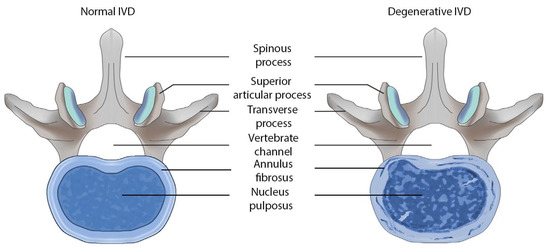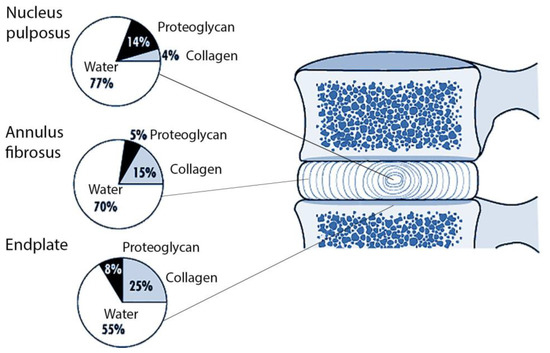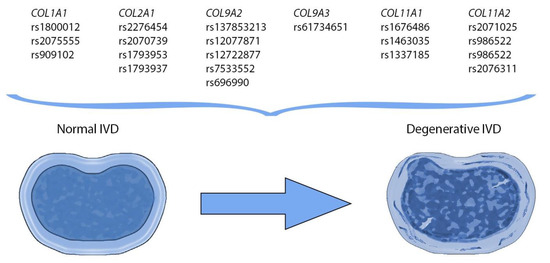2. Current Insights on Polymorphisms in Collagen-Encoding Genes
The prevalence of IVDD in the general population varies from 36 to 93% depending on age
[11][12]. The estimated transition age at which intervertebral discs lose the growth potential and begin degenerating is 13.3 years. The estimated disc degeneration rate is 0.0344/year
[13]. Meta-analysis by Brinjikji (2015) demonstrates that MR imaging evidence of disc bulge, degeneration, extrusion, protrusion, Modic 1 changes and spondylolysis are more prevalent in adults 50 years of age or younger with back pain compared with asymptomatic individuals
[14]. Although various environmental factors such as smoking, age, gender and mechanical load increase the risk of IVDD, it is hypothesized that up to 74% of the etiology of IVDD is due to heritability
[15][16]. IVDD is most common causes of impairment and disability for middle aged and older people: spine stiffness, neck pain and back pain. This explains the importance of searching for modifiable and non-modifiable risk factors for the degenerative process.
Potential causes of the IVDDs include declining nutrition, loss of viable cells, cell senescence, post-translational modification of matrix proteins, accumulation of degraded matrix molecules and fatigue failure of the matrix. The most important of these mechanisms appears to be decreasing nutrition of the central disc that allows accumulation of cell waste products and degraded matrix molecules, impairs cell nutrition and causes a fall in pH levels that further compromises cell function and may cause cell death
[11].
IVDD is a complex condition with environmental factors and multiple genes likely acting together to determine an overall degenerative phenotype. IVDs contain an abundant extracellular matrix of proteoglycans and collagens
[11][17]. The IVD matrix comprises mainly a fibrillar collagen network that offers tensile strength and aggregating proteoglycans that resist compressive forces. These major components form a mesh suited for containing water molecules, especially in the nucleus. An intact extracellular matrix is essential to normal disc function. The ability of IVD tissue to withstand mechanical forces largely depends on the structural integrity of the matrix and on the physiological balance of collagen, proteoglycan and water content
[18].
IVDD is believed to begin as early as the second decade of life and is viewed by most as an inevitable consequence of ageing. Despite its prevalence, there is no clear distinction between IVDD and normal maturation, nor is it clear why IVDD progresses slowly in some patients, whereas in others more rapid destruction of the IVD can occur. Various risk factors were thought to be associated with IVDD, including environmental, ergonomic and biometric. There is now growing evidence that genetic factors play a decisive predictive role in the development of IVDD (
Figure 3)
[19].
Figure 3. Candidate genes predisposing to intervertebral disc degeneration in humans.
Many recent studies show the clinical significance of the association of the rs1800012 polymorphism of the
COL1A1 gene with an increased risk of IVDD
[20][21][22][23][24][25]. In addition, recently, the SNV rs909102 of the
COL1A1 gene has been studied, but its association with IVDD in the Iranian population has not been reliably proven
[26]. At the same time, the role of the studied SNVs of the
COL1A2 gene in the development of IVDD is questionable, which explains the need for additional studies in various racial and ethnic groups of patients.
In 2016 and 2017, two similar associative genetic studies were carried out, the first of which showed that the SNVs rs2276454 and rs2070739 of the
COL2A1 gene are predictors of the development of IVDD in adult patients
[27]. The second study also confirmed that the rs2276454 variant is associated with an increased risk of developing IVDD
[28].
The role of SNVs of the genes encoding type IX collagen chains (
COL9A1, COL9A2 and
COL9A3) in the development of pathological processes in IVD is also being actively studied at the present time. At the same time, increased attention of researchers has been paid to the genes
COL9A2 and
COL9A3. The rare Trp2 allele (rs137853213) of the
COL9A2 gene has been well studied. As a result, it was shown that the inheritance of the Trp2 allele is associated with IVDD in the families of all patients
[7][29].
However, according to recent studies, the above-mentioned SNV of the
COL9A2 gene did not show its reliable association with IVDD in the Iranian population
[26]. In the latest study of Finnish patients, it was shown that the frequency of carriage of the Trp3 allele (rs61734651) in the
COL9A3 gene among patients with IVDD was statistically significantly higher than in healthy people in the control group
[29].
Conducted by Wu et al. in 2018, a large meta-analysis of the association between the
COL9A2 and
COL9A3 SNVs showed that the rs12077871, rs12722877 and rs7533552 SNVs of the
COL9A2 gene and the rs61734651 SNV of the
COL9A3 gene were not significantly associated with the development of IVDD. The authors concluded that more large-scale and well-designed studies are needed to confirm this hypothesis
[30].
Other authors have found a statistically significant association between SNV rs1676486 of the
COL11A1 gene and hernia of the lumbar IVD in Asians (using the example of the Japanese
[7][31] and Chinese
[32] populations).
Another large study, conducted with the participation of Finnish men, showed that two SNVs (rs1463035 and rs1337185) of the
COL11A1 gene and one of the three studied SNVs (rs2076311) of the
COL11A2 gene were associated with certain abnormalities of the IVD surface and signal intensity from it according to MRI data. In the same study, the SNV of the genes
COL1A1 (rs2075555) and
COL9A1 (rs696990) also provided reliable evidence of an association with the presence of pathological signals from IVD according to MRI of the spine
[7][24][33].
A study by Yang X. et al. in 2018, in the Chinese Han population, not only indicated an association with degeneration of the lumbar IVD in the rs2071025 SNV of the
COL11A2 gene, but also that another SNV of this gene (rs986522) significantly increases the risk of lumbar IVDD in women
[34].
Some limitations of our study should be noted (Table 1). First, only publications in English and Russian were searched and publications in other languages were excluded. Secondly, the present work did not set out to conduct a meta-analysis.
Table 1. Candidate genes encoding collagens and their single nucleotide variants associated with degeneration of intervertebral discs in humans.
|
Gene, Chromosomal Locus
|
Single Nucleotide Variants
|
Protein
|
Source
|
|
COL1A1
17q21.33
|
rs1800012
rs2075555
rs909102
|
Alpha 1 chain of collagen type I
|
[7][20][22][23][24][25][26]
|
| COL1A2
7q21.3
|
n/a *
|
Alpha 2 chain of collagen type I
|
[35][36]
|
|
COL2A1
12q13.11
|
rs2276454
rs2070739
rs1793953
rs1793937
|
Alpha 1 chain of collagen type II
|
[1][27][28].
|
|
COL9A1
6q13
|
n/a *
|
Alpha 1 chain of collagen type IX
|
[7][29]
|
|
COL9A2
1p34.2
|
rs137853213
rs12077871
rs12722877
rs7533552
rs696990
|
Alpha 2 chain of collagen type IX
|
[7][37][29][38]
|
|
COL9A3
20q13.33
|
rs61734651
|
Alpha 3 chain of collagen type IX
|
[37][29][30]
|
|
COL11A1
1p21.1
|
rs1676486
rs1463035
rs1337185
|
Alpha 1 chain of collagen type XI
|
[7][24][29][31][32]
|
|
COL11A2
6p21.32
|
rs2071025
rs986522
rs986522
rs2076311
|
Alpha 2 chain of collagen type XI
|
[7][24][33][34]
|
* n/a–not available.
The authors undoubtedly see the need to plan and conduct large, randomized studies on the pathology under consideration with the inclusion of representatives of different ethnic and racial groups, different age groups of both sexes (men and women).
With more than 20 unique SNVs of candidate genes associated with IVDD, the molecular changes in the associated collagens or pathology of the IVDs are not yet fully understood. In the coming years, research targeted toward fully understanding the protein changes of extracellular matrix of IVDs due to the already identified SNVs is crucial. If we can fully understand the molecular changes involved in IVDD, then creating targeted therapeutics based on genetic profiling becomes a possibility. With improved understanding of the genetic variants associated with IVDD and rapid genomic analysis available through next-generation genotype sequencing and DNA tests, the possibility of providing effective personalized medicine can become a reality in the future
[39][40][41].
3. Conclusions
According to genome-wide and associative genetic studies, the following candidate genes that play a role in IVD biology in humans and the genetic basis of collagen degeneration of the annulus fibrosus and nucleus pulposus are of the greatest interest to researchers: COL1A1, COL2A1, COL9A2, COL9A3, COL11A1 and COL11A2. In addition, the role of genes COL1A2, COL9A1 and others is being actively studied. This is important for the development of modern methods of drug and non-drug strategies for the prevention and treatment of IVD pathology.
A large number of SNVs of the candidate genes are being actively studied as genetic predictors (biomarkers) of dysfunction and collagen degradation as one of the mechanisms of IVDD in adults. On the one hand, this indicates the relevance of the problem from a scientific and clinical point of view. On the other hand, this indicates that, at present, there are more questions than answers about the genetics of the interdisciplinary spine pathology under consideration.



